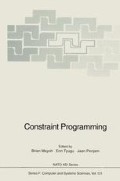Abstract
This paper discusses value propagation on functional constraint networks. We first focus on conventional “first-order” networks, and then show how the technique generalizes for what we call higher-order networks. Value propagation is attractive because of its simplicity and efficiency. Although it cannot solve all satisfiable networks (since it cannot break loops of constraints) and it may suggest solutions to unsatisfiable networks (since it does not discover inconsistency), it is of significant practical value. We describe several algorithms for planning value propagation, and point out that planning can be regarded as proof search in intuitionistic propositional logic.
Access this chapter
Tax calculation will be finalised at checkout
Purchases are for personal use only
Preview
Unable to display preview. Download preview PDF.
References
Borning, A. H. 1981. Programming language aspect of ThingLab: A constraint-oriented simulation laboratory. In ACM Transactions on Programming Languages and Systems 3 (4), 353–387
Dechter, R. Pearl, J. 1989. Tree clustering for constraint networks. Artificial Intelligence 38, 353–366
Dechter, R. 1992. From local to global consistency. Artificial Intelligence 55 (1), 87107
Dikovski, A. 1985. Solving algorithmic problems of synthesis of programs without loops in linear time. System Programming and Computer Software 3, 38–49
Hyvönen, E. 1992. Constraint reasoning based on interval arithmetic: the tolerance propagation approach. Artificial Intelligence 5813, 71–112
Kanovich, M. 1991. Efficient program synthesis: semantics, logic, complexity. In Proc. Int’l Conf. on Theoretical Aspects of Computer Software, 615–632. LNCS 526 Berlin: Springer-Verlag.
Mackworth, A. 1992. The logic of constraint satisfaction. Artificial Intelligence 58 (13), 3–20
Mints, G., Tyugu, E. 1983. Justification of the structural synthesis of programs. Science of Computer Programming 2 (3), 215–240
Montanari, U., Rossi, F. 1991. Constraint relaxation may be perfect. Artificial Intelligence 48, 143–170
Author information
Authors and Affiliations
Editor information
Editors and Affiliations
Rights and permissions
Copyright information
© 1994 Springer-Verlag Berlin Heidelberg
About this paper
Cite this paper
Tyugu, E., Uustalu, T. (1994). Higher-Order Functional Constraint Networks. In: Mayoh, B., Tyugu, E., Penjam, J. (eds) Constraint Programming. NATO ASI Series, vol 131. Springer, Berlin, Heidelberg. https://doi.org/10.1007/978-3-642-85983-0_5
Download citation
DOI: https://doi.org/10.1007/978-3-642-85983-0_5
Publisher Name: Springer, Berlin, Heidelberg
Print ISBN: 978-3-642-85985-4
Online ISBN: 978-3-642-85983-0
eBook Packages: Springer Book Archive

